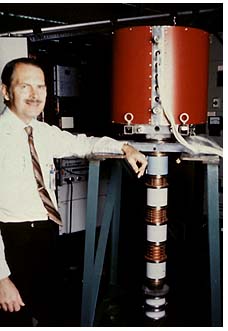Television Transmission Technology
A spinoff system that offers a substantial improvement in UHF-TV transmission efficiency is the VKP-7990 MDC Klystron, which is manufactured by the Microwave Power Tube Division of Communications and Power Industries, (CPI), Palo Alto, California. There are 90 CPI klystrons in operational service at 36 UHF-TV stations.
The MDC klystron is the result of a multiyear cooperative development program by a group that included Lewis Research Center, the National Association of Broadcasters, the Public Broadcasting System, TV transmitter manufacturers, and Varian Associates, Inc., also of Palo Alto. Throughout the klystron development period, the Microwave Power Tube Division was part of Varian, but Varian's Electron Devices Group has since separated from Varian to become CPI.
The program was initiated to address a problem experienced by the UHF segment of the TV industry: for adequate reception, UHF stations need greater transmitter power than their VHF counterparts and, additionally, UHF transmitters are inherently less efficient; thus, UHF station operators had to pay substantially higher electric utility costs, a significant competitive disadvantage.
The development group sought a way to make available to UHF operators power amplifying devices with efficiencies comparable to VHF. The indicated line of approach was to incorporate into UHF transmitters a power amplifying device known as the Multistage Depressed Collector (MDC) developed a decade earlier at Lewis Research Center to enhance the efficiency of communications satellite transmissions; the MDC allowed satellites to transmit more powerful signals, thus enabling the use of smaller, less costly Earth stations for signal reception.
The klystron is a vacuum tube used to generate and amplify ultrahigh frequencies. It draws radio frequency energy from a high voltage electron beam but does so at very low efficiency levels; most of the energy is dissipated as waste heat. The concept behind the Lewis/Varian development was that the MDC could recover much of the wasted energy by recycling a large part of the electron beam energy, in effect doubling the amount of the beam energy being converted to radio frequency energy.
The program began in 1984. Within the initially targeted three years, a successful MDC klystron had been produced by Varian and thoroughly tested. It took another two years to integrate the klystron into a complete transmitter for field operation. Varian started commercial production of the tubes in 1990 and CPI took it over in August 1995.
CPI continues to monitor the klystron's performance. According to CPI senior scientist Earl W. McCune, the total operating time for the tubes in service has exceeded three million hours; projected Mean Time Between Failures is 60,000 hours; the klystrons show no significant adverse effects due to incorporation of the MDC feature; and the initial project goal of cutting electric power consumption by half in UHF-TV transmitters has been realized.

The CPI MDC klystron cuts the electric power consumption of UHF-TV transmitters by half.













